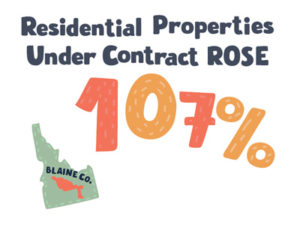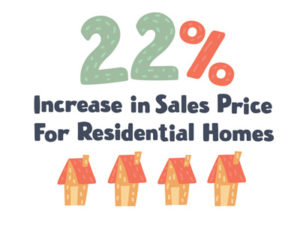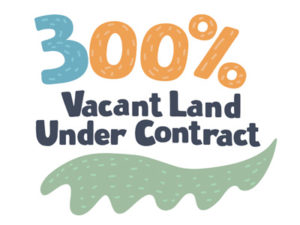If you’ve caught any news cycle over the past few months, you have likely heard a similar sentiment: “City dwellers head to small towns,” or “The urban flight from cities continues.” Although definitive stats about the long-term changes in populations based on the pandemic are hard to quantify just yet, ask any mountain town resident from Truckee, California, to Aspen, Colorado, if they have noticed an uptick in moving trucks, out-of-area drivers licenses, or the like, and you’ll likely here a resounding, “Yes.” And if you ask a local realtor, that “Yes” will become emphatic. People answering the call of the mountains to Idaho is no different.
“We have a really good quality of life here,” says Katherine Rixon, an owner and broker with Keller Williams Sun Valley. Rixon has been in real estate in the region since 2002. “Even though we are still wearing masks and being really careful, we have [access] to the outdoors.”
 Last March when the COVID-19 pandemic and lockdown left Americans stuck inside, life for mountain town residents was different than those in nearby big cities. Yes, the pandemic was and continues to be ever-present, but when storefronts and amenities shuttered coast to coast, Wood River Valley residents weren’t entirely confined to one-bedroom apartments or crowded existences; reprieve could be found outside.
Last March when the COVID-19 pandemic and lockdown left Americans stuck inside, life for mountain town residents was different than those in nearby big cities. Yes, the pandemic was and continues to be ever-present, but when storefronts and amenities shuttered coast to coast, Wood River Valley residents weren’t entirely confined to one-bedroom apartments or crowded existences; reprieve could be found outside.
Locally, real estate agents and every other industry collectively held their breath as business came to a screeching halt. But come June, the market started to shake up and, by July, they took off at lightning speed.
The Sun Valley Board of Realtors reported a 300 percent increase in vacant land under contract from July 2019 to July 2020 in Blaine County. Residential properties under contract rose 107 percent, from 71 under contract in July 2019 and 147 under contract in July 2020.
“We never would have expected that a global pandemic would make our real estate world go this way,” Katherine says. She noted that 2019 was a record sales year for her firm. “Not only have we caught up to that, but we are beyond 2019 by 20 percent volume closed, even with being locked down for forty some days.”
While there is no hard data yet to show just where people are coming from and if they are in fact leaving the city, the daily inquiries realtors like Katherine Rixon continue to receive are enough to show the trends.
“What has changed here is, in the past, people would come for a week or two to visit,” she says. “Right after COVID, we had calls from people wanting to come for the entire summer, and then move here. They put their stuff down and just stayed. Now, we are getting calls from two or three new clients every day asking about properties, most of them are big cities.”
The biggest feeders, she says, are larger urban areas on the West Coast, like San Francisco, Los Angeles, Seattle, and Portland.
Reid Sanborn, the Sun Valley Board of Realtors board president and an associate broker and partner with Engel & Völkers, attributed the rise in city dwellers leaving to a new-found ability to work anywhere, even if only for a year or so, as well as people following through on a rooted desire to eventually call the mountains home.
“There have always been a group of people living in another location who have had Sun Valley on their radar,” Sanborn says. “With the virus and getting locked in the city or suburbs, they accelerated their timeline to buy and said, ‘We want to have our spot in the mountains.’”
Sanborn said this is a very similar story to what other resort towns in the region like Park City, Utah, and Jackson Hole, Wyoming, are seeing.
“Second, people were told not to go back to work,” he says. “A lot of clients are saying they want to come here, and if they have to go back to work, they can transition to a second home here.”
Tech giants like Google and other large employers like Sony Music and Viacom, announced this summer that its employees will be working from home until at least summer 2021. Other companies like Facebook, Twitter, Zillow, and Shopify, are allowing employees to work from home indefinitely.
“In the past, people had to travel for work and questioned if the [local] airport was good enough or if heavy snowfall would stop flights,” Katherine echoed. “Now, the world has been forced to accommodate online working. People who felt like they couldn’t live here, now can.”
When COVID-19 first began, Sanborn was part of a meeting with various Engel & Völkers brokerages in Breckinridge, Aspen, Jackson Hole, Telluride, and others, that looked at national trends. In these meetings, Sanborn said other firms reported seeing digital traffic on listings increase, and collectively each group saw an increase in inquiries about mountain properties.
 “And as soon as the restrictions lifted, you then saw people driving to the area to visit,” he explained. “We saw it happen together so it’s a national trend, not just a localized trend.”
“And as soon as the restrictions lifted, you then saw people driving to the area to visit,” he explained. “We saw it happen together so it’s a national trend, not just a localized trend.”
Now, demand is high, and supply is low. MLS data from the Sun Valley Board of Realtors shows the median Blaine County sales price for residential homes in July 2020 at $545,000, a 22 percent increase from the same time in 2019.
“We have people who are reaching for top dollar,” Sanborn says. “I don’t see properties jumping 30 percent next year.”
“We are in selling season and coming off quarantine,” he continued, “so I think we will see a sustained leveling off, but a sustained growth for the next year or two, because builders aren’t specking a lot of homes right now. The buying will slow down, and we will come back to something like we’ve seen the past couple of years.”
Looking ahead, Katherine says there are so many things that could continue to throw the national economy out of whack, from unemployment to wildfires across the nation.
“But Sun Valley has already been a value compared to other resort markets, and it doesn’t look like COVID-19 is going anywhere quickly.”
Sanborn hopes the Wood River Valley will continue to see the local economy moving forward, while taking a look at community housing policies. “If we can keep our local economy going it helps everyone, but also making sure our community grows as a whole and not just the people who can afford to buy the bigger homes.”
Until then, no matter the reason, the mountains are continuing to beckon people out west. And if you’ve been to Sun Valley, you know why.


